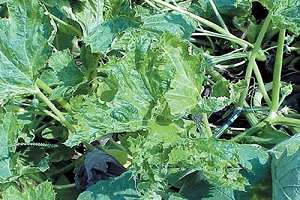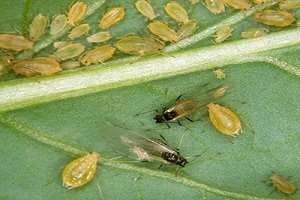By Marissa Schuh
While there has been an increase in consumer demand for so-called “ugly” pumpkins, sometimes traditional jack-o-lantern, pie and mini pumpkin varieties are found with unwelcome warts, indentations and coloration. This may seem like it could be some kind of seed mix-up, but the culprit may actually be a plant virus.

There are many viruses that impact all kinds of vine crops, all producing similar symptoms that make identifying the exact virus impossible without doing lab tests. Exact virus identification isn’t as critical for virus management since there isn’t any way to cure or alleviate symptoms in an afflicted plant. One of the most common viruses is cucumber mosaic virus, which can infect a variety of weeds in addition to cucumbers, melons, squash, pumpkins and other vegetable crops. This multitude of hosts allows the virus to be present across the landscape, and it moves into cultivated crops through aphids, who introduce the virus into new plants after feeding on an infected plant. Other viruses include watermelon mosaic virus 2 and zucchini yellows mosaic virus, which are also transported via aphids.
Inspect the plant itself, not just the fruit, when confirming a virus incidence. Look for contorted leaves that are shriveled and puckered. Another symptom is a change of coloration in the affected leaves, where seemingly random portions of the leaf are a few shades lighter or brighter. These kinds of leaf distortion are also symptomatic of herbicide injury. However, if you also see discolored, deformed fruit, you have good evidence that a virus has infected the plant.
Undersized fruit is another symptom. It is possible that only the more recently developed portion of the vines and newly formed pumpkins will show symptoms, as the virus can only move outward from the point of infection.

Virus control can be difficult, as an infected plant cannot be “cured” and the insects that move the disease around are hard to remove. The most effective control strategy is to reduce aphid feeding; stylet oils are labeled for use on many cucurbits and trials in melons and zucchini suggest stylet oils can aid in virus control during times of low virus pressure. Unfortunately, aphid arrival to the field is hard to predict and the aphids that land on your crop may not be carrying the virus. Insecticide treatments may be part of the solution, but treating for prevention is usually unfeasible, as virus infection can happen from just one aphid feeding on the plant. Even if the sprays do kill infected aphids, they will be killed after feeding on the plant, meaning that virus transmission may have already occurred.
While these immigrant aphids can infect a portion of the crop, they can further spread the viruses from one plant to another if aphids are allowed to build up in the field. This is complicated by the fact that many perennial weeds can host viruses and aphids, making weed control another aspect of the virus management equation. Checking regularly for aphids and intervening before their numbers get high will likely reduce the overall number of plants with virus symptoms. Aphids are notorious for quickly building up large populations in hot and humid weather. Often, the reason behind this is that natural enemies—insects such as lady beetles that eat aphids—are wiped out by insecticide applications, and aphids can reproduce without control. For this reason, using insecticide judiciously or choosing products that are less harmful to beneficial insects, such as stylet oils, Fulfill or Beleaf, can save natural enemies while suppressing aphids.

It is important to know the susceptibility of your varieties to viruses; this is usually indicated when buying seeds. In seed catalogues, tolerant varieties are noted with abbreviations like CMV (cucumber mosaic virus) and ZYMV (zucchini yellows mosaic virus). Cornell University’s Table of Disease Resistant Varieties also highlights virus-tolerant varieties. If you choose to go with a variety known to be susceptible to viruses, apply insecticides during hot and humid periods when the weather is most conducive to aphid reproduction and movement. An additional factor to be aware of is weather systems, especially from the south that can blow in aphids from others areas. Thus, if using a susceptible variety during hot and humid weather, and with weather fronts moving in from the south, chances are great that virus infection will occur and you will need to thoroughly and regularly scout your plants for aphids.
If you direct market pumpkins, simple marketing strategies may allow striped or bumpy pumpkins to be sold with other novelty pumpkins. While these pumpkins may be smaller, greener and lumpier than what you envisioned, the virus infection only impacts appearance, not the shelf-life of the pumpkin.
Source: msu.edu